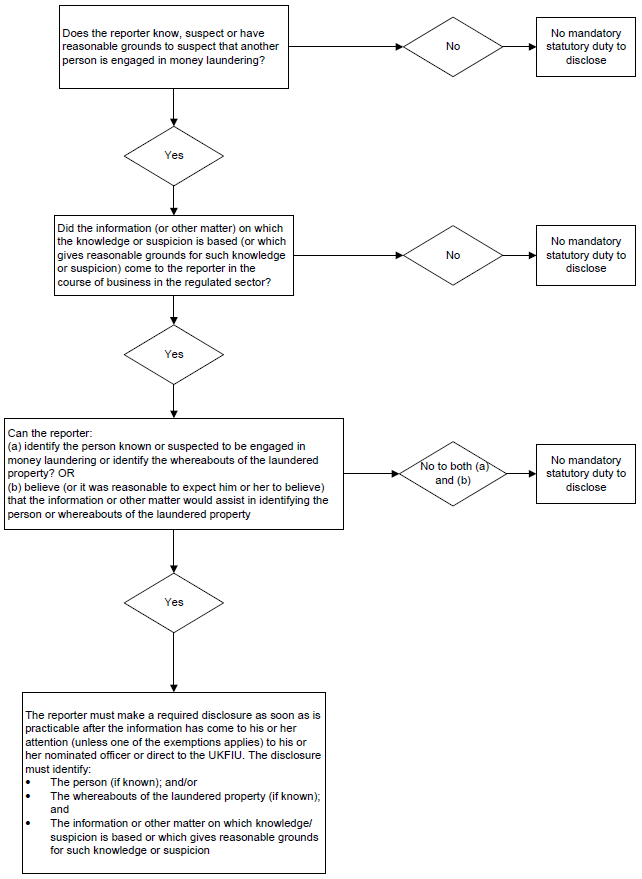Chapter 5: Suspicion
Introduction
5.1 In this chapter we discuss our provisional proposals in relation to the test of suspicion as it applies in the money laundering offences and in the disclosure offences. We examine consultees' responses to our proposals and conclude by making recommendations for reform.
The current law
5.2 As we discussed in the Consultation Paper, the concept of suspicion remains the keystone of the anti-money laundering regime. It underpins the suspicious activity reporting process and acts as the trigger for reporters to disclose information in Suspicious Activity Reports («SARs») in two ways.
Authorised disclosures: sections 327(2)(a), 328(2)(a), 329(2)(a) and 338 of POCA
5.3 First, it governs voluntary disclosures of suspicious activity where the reporter seeks to benefit from an exemption from committing an offence («authorised disclosures»). Suspicion is the threshold for such voluntary disclosures because it is the minimum threshold of the mental element for the money laundering offences. Once a person suspects that property is criminal property, they are liable to be prosecuted if they perform one of the acts prohibited in sections 327 to 329 of the Proceeds of Crime Act 2002 («POCA»). They will not, however, commit an offence if they make an authorised disclosure (DAML SAR) and obtain notice of consent to act from the United Kingdom Financial Intelligence Unit («UKFIU»). Suspicion therefore triggers the filing of a SAR and engages the resources of the UKFIU who will process the SAR and reach a decision on consent within the statutory notice period of seven days. If consent is refused, a statutory moratorium period of 31 calendar days begins. During that period the suspicious transaction cannot be processed or the individual risks commission of a money laundering offence under sections 327 to 329 of POCA.
Required disclosures: sections 330-331 POCA
5.4 Secondly, the concept of suspicion underpins mandatory disclosures of suspicious activity. In these cases, the reporter risks commission of a criminal offence if they fail to disclose to the National Crime Agency («NCA») when they know, suspect or there are reasonable grounds to know or suspect that another person is engaged in money laundering («required disclosures»). These disclosures do not require a decision from the UKFIU. They are made available by the NCA to law enforcement agencies who can use software tools to derive intelligence from the data.
Meaning of suspicion
5.5 In our Consultation Paper, we observed that there is no statutory definition of suspicion. We examined how the courts have interpreted the concept in the context of both the money laundering offences and the disclosure offences. The interpretation of suspicion in R v Da Silva has been widely adopted by the courts and is relied upon as a guiding principle by those with reporting obligations:
The defendant must think that there was a possibility, which was more than fanciful, that the relevant fact existed.
5.6 We noted that prior to the enactment of the principal money laundering offences in Part 7 of the POCA, «reasonable grounds to suspect» was used to describe the threshold for a money laundering offence in section 93C(2) of the Criminal Justice Act 1993. We examined the case of R v Saik and set out the House of Lords interpretation of «reasonable grounds to suspect» in the context of section 93C(2), the wording of which was «knowing or having reasonable grounds to suspect that any property is the proceeds of criminal conduct». We concluded that the interpretation in Saik laid down a cumulative test of subjective suspicion coupled with objective grounds for holding that suspicion.
5.7 In relation to the disclosure offences in Part 7 of POCA, because the fault element is expressed as being «knowledge, suspicion or reasonable grounds to suspect», it is sufficient that the prosecution prove that reasonable grounds existed without having to demonstrate that the reporter actually suspected. We analysed the recent case of R v Sally Lane and John Letts. The Supreme Court clarified the meaning of reasonable cause to suspect in the context of section 17(b) of the Terrorism Act 2000. In doing so, Lord Hughes, on behalf of the unanimous Court, acknowledged that the cumulative test discussed in Saik was one legitimate interpretation of «reasonable grounds to suspect». However, Lord Hughes put beyond doubt that the words «reasonable grounds to suspect» in the context of the similarly constructed disclosure offences in the Terrorism Act were to be interpreted as an objective test. In other words, as long as reasonable grounds existed, there was no requirement on the prosecution to prove that the reporter held a subjective suspicion.
The obligations of the reporter
5.8 A reporter's obligations under POCA are complex. Understanding the obligation to make a required disclosure and how it intersects with the authorised disclosure exemption is challenging. The following non-exhaustive flow charts outline the complicated process that a reporter is required to undertake to ensure that they are complying with their obligations under Part 7 of POCA.
Required disclosures

